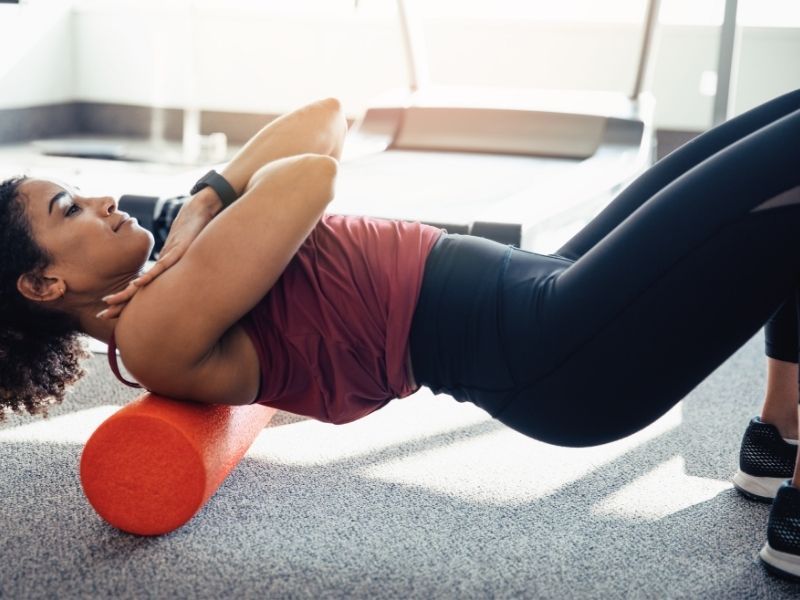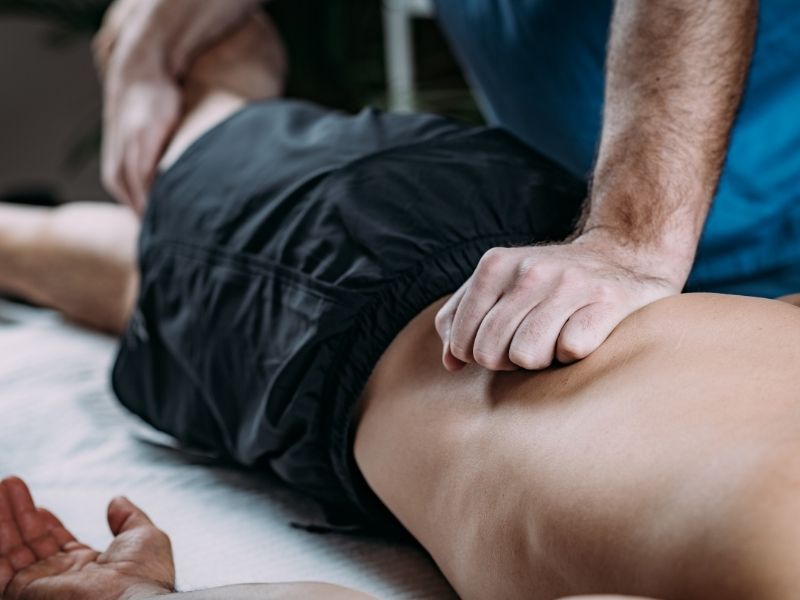How To Get The Best Stretch For Upper Back Pain Relief

When it comes to looking for the best stretch for upper back pain, there are a number of factors to consider. There are multiple muscles and spinal joints that may be contributing to the pain, as well as potential underlying medical conditions which should be ruled out. (Always consult with your doctor if experiencing severe pain!)
The majority of mid and upper back discomfort can simply be related to musculoskeletal issues, and the following stretches for upper back pain relief may be very helpful.
Let’s learn how to stretch your upper back!
Shoulder Crossbody Stretch For Upper Back Pain Relief
The crossbody shoulder stretch targets the muscles of the upper back right between the shoulder blades, but it also addresses tension in the back side of the shoulder itself.
I would place this at top of my list when it comes to stretches for upper back pain between shoulder blades.
This is an easy stretch for upper back pain that can be done throughout the day, especially if you find yourself hunched over at your desk all day long.
- Bring your arm across your body and use the opposite hand to assist the stretch
- You should feel the stretch on the back of your shoulder and upper back
- If you feel pinching or discomfort in the shoulder joint, reposition and try again, or omit the stretch
- Hold for approximately 30 seconds on each side
Overhead Tricep Stretch
The overhead tricep stretch addresses both the tricep muscles, but also the lat muscles, which run from your upper arm to your lower back.
Tightness in this muscle contributes to rounded shoulders, therefore increasing the amount of strain in your upper mid back muscles.
While performing this stretch, as an extra bonus, you can side bend your torso the OPPOSITE side of the arm you are stretching.
- Reach up and behind your head with one arm and try to touch your upper spine with your finger tips
- Use the opposite hand to grasp your elbow to assist the stretch by gently pulling
- Hold for approximately 30 seconds on each side
Foam Roll Pec Stretch
The pec stretch over a foam roller isn’t an upper back stretch, but it will certainly reduce strain on the upper back muscles.
When the pectorals are tight (especially the pec minor), it pulls the shoulder down and forward. This rounding of the shoulders lengthens the rhomboids, mid and lower traps, and spinal extensors.
This puts these muscles at a mechanical disadvantage, making them more prone to fatigue, especially during activities of prolonged computer work, etc. If you get upper back pain when stretching, you’ll likely benefit much more from this approach.
Essentially by stretching the pecs your shoulders are repositioned, and it can give you relief from upper back pain.
VIDEO
- Lay vertically on a 6 inch foam roller
- Starting with your arms straight up to the sky, lower them out to your sides until they reach a stretch
- If your arms don’t reach the ground, lower then down toward your sides until they do
- Hold for 30-60 seconds
Foam Roll Thoracic Spine
Another potential contributor to upper back pain is often lack of mobility in the thoracic spine. The most common issue is lack of extension, leaving the vertebra stuck in a persistent state of flexion.
This flexion position lengthens the spinal extensor muscles, causes the rib cage to internally rotate, and can contribute to non-optimal position of the diaphragm. As a result, sub-optimal breathing patterns can develop and lead to overactivity and fatigue in the mid and upper back muscles.
While not specifically a stretch for upper back pain, one of the best ways to start addressing this situation is by improving mobility of the thoracic spine with the foam roller.
VIDEO
- Start by laying over a foam roll so that your torso is perpendicular to the roll
- Your starting point should be toward the upper part of your spine, but never roll on your neck
- Place your hands together and behind your head to support your neck
- Slowly tip your body backward until you reach a point of moderate pressure, but comfortable
- Hold for 2-3 seconds, then return back to the start. Repeat 2 more times
- Roll over the roll 3-4 more inches, and repeat
- Repeat this process until you reach the lower part of your thoracic spine. You will know this because its quite tender
- Do NOT roll on your lumbar spine!
Supine Swiss Ball Stretch
As mentioned above, excess rounding of the thoracic spine (kyphosis) is a potential contributor to tension and feeling the constant need for an upper back stretch.
The abdominal muscles can also have tightness that can limit thoracic extension. Thus, stretching them can reduce upper back tension.
VIDEO
- Start by sitting on a large swiss ball (65 cm or larger)
- Walk your way down as you lay back over the ball
- Roll forward and backward until you find a point of comfort where there is no stress on on your lower back or neck
- Hold for this position while breathing for 30-60 seconds
Swiss Ball Lat Stretch
The lat muscles are often short and tight, which leads to both rounding of the shoulders, as well as increased tension down toward the lower back.
Lat stretch for upper back pain is fantastic because they are such long muscles that perform many important functions.
VIDEO
- Start by placing your arms over the top of a swiss ball
- While pressing your arms straight out in front of you, lower your upper body down through your arms until you feel a stretch in your armpit area
- You may also additionally round your lower back (posterior pelvic tilt) to increase the stretch
- Hold this position while breathing deeply for 30 seconds
There is no single best stretch for upper back pain relief, but this list is my go-to for addressing the key potential contributors. Also be sure to check out upper trap stretches for additional ways to address upper back muscle tension.
Sam Visnic
I’ve spent my life studying the fundamental aspects of human health with a focus on movement and clinical massage therapy. In a world of specialists, surgical procedures, drugs and quick fix remedies, I’m committed to finding and developing strategies that help people stuck at the “gap”. Over the last 20 years I’ve studied dozens of systems and methodologies for uncovering the root cause of aches and pains, along with postural and movement issues. Pain science, the art and science of hands-on soft tissue massage techniques, myofascial release, and coaching movement is essential in my practice. Integrating different methods but above all deciphering WHEN to use different techniques with different people and situations, along with integration of movements that people want to be able to do again is the key to long term success with my incredible track record with clients. Understanding the various elements that contribute to conditions and the power of communication and education makes my Release Muscle Therapy program separate from other hands-on therapy approaches.
Blogs You May Be Interested In
Categories
-
Deep Gluteal Pain Syndrome
-
Deltoids
-
Fallbrook
-
Foam Rolling
-
Glutes
-
Hamstrings
-
Hypnosis For Pain
-
Lats
-
Levator Scapulae
-
Lifestyle
-
Massage Therapy
-
Mobility
-
Movement and Exercise
-
Murrieta
-
Muscles
-
Nutrition
-
Obliques
-
Pain
-
Pectorals
-
Piriformis
-
Plantar Fasciitis
-
Product Review
-
Psoas
-
Quadratus Lumborum
-
Quadriceps
-
Rhomboids
-
Serratus Anterior
-
SI Joint
-
Sternocleidomastoid
-
Stretching
-
Subscapularis
-
Temecula
-
TMJ
-
Trapezius
-
Uncategorized
















